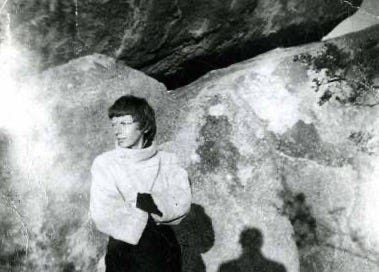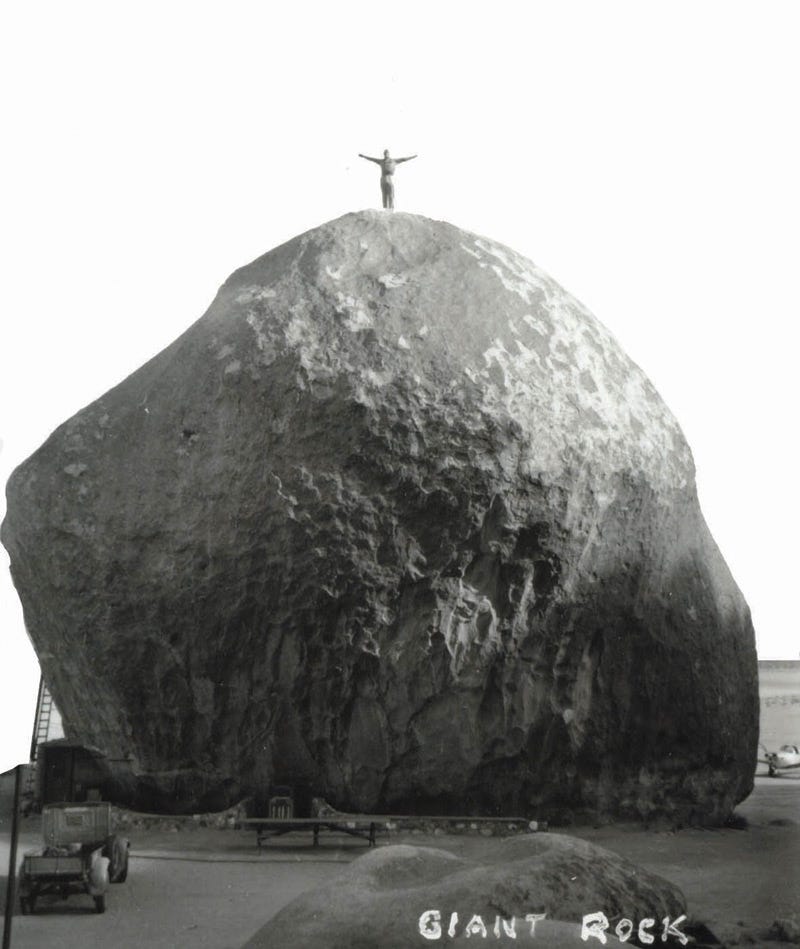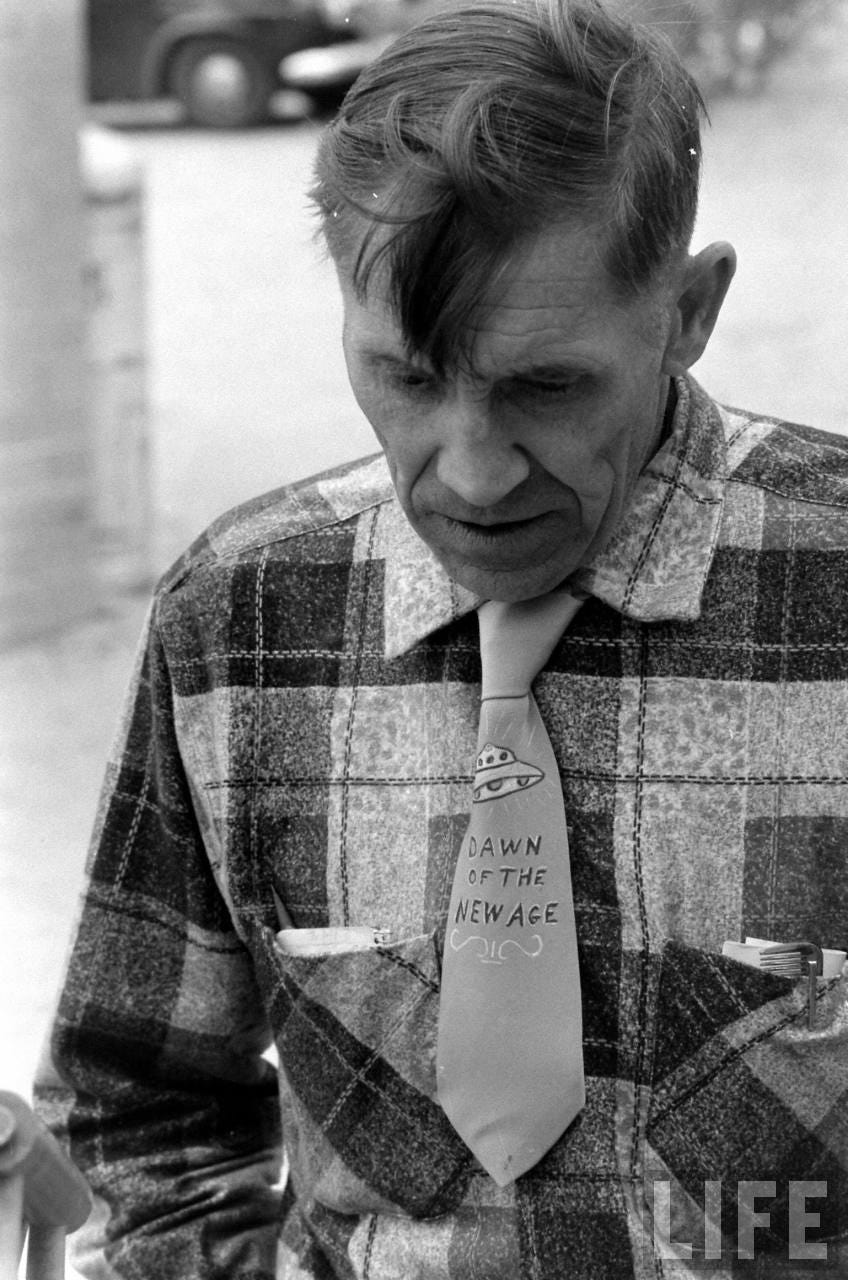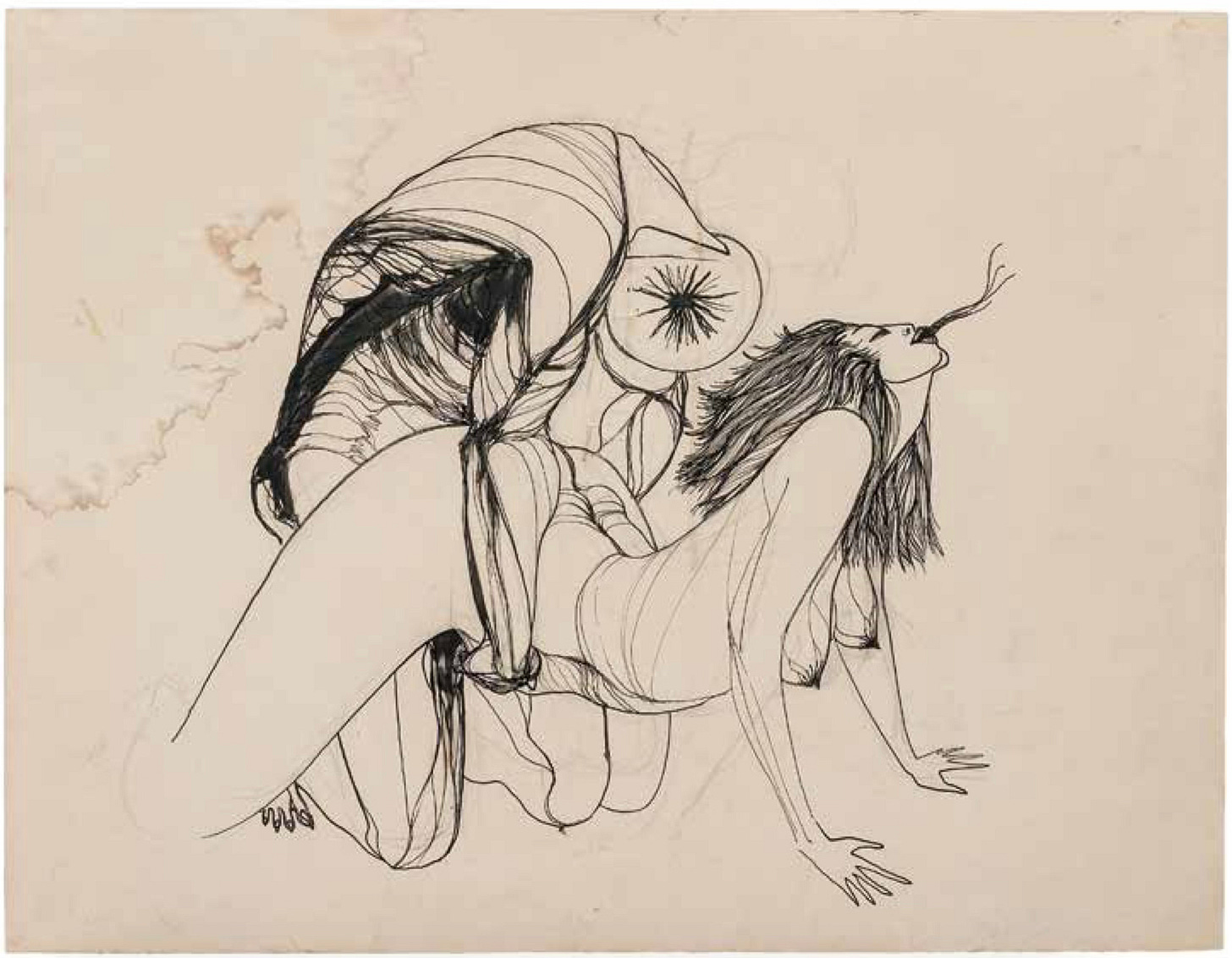Cameron disembarks from the hearse, it is streaked iron-red with dirt and the chrome bumpers are pitted with spider eyes of black oxide. She slowly turns, attuning her body like an aerial beneath the desert skies. In this manner she can receive the messages of the star-people. The sand hisses about her ankles, thin gritty rivulets of quartz crystals which possess the secrets of time. Perhaps today will be the day?
It is less than an hour on the straight desert roads from Pioneertown and her broken down ranch. The suspension on the hearse rolls like a mattress through the compressions, and the springs creak and groan. Her baby Crystal sleeps on in the back. They pass the dirt strip airfield where Howard Hughes would periodically land one of his planes; an airfield Hughes owned because of its proximity to his friends who spoke with the strangers.
Howard Hughes was the last aerospace employer of Jack Parsons, which makes the desert roads and runway part of a magical cat’s cradle. It was a job that ended in scandal, and the loss of Parsons’s security clearance. If he had not been fired, there would have been no need to take the chemical job, and well, we know how that ended. Kenneth Anger would later insist that Howard Hughes was implicated in Jack’s death. Perhaps his anecdote is a repetition of something Cameron intuited in the desert, scented on the wind. For Anger to wear another’s story in his own buttonhole is not without precedent. I suspect that it was Cameron who first nurtured the suspicion of Hughes, even taking his presence at Giant Rock as a sign that Jack was not far away.
Cameron had located herself at UFO central at the dawn of the folk saucer cult. Giant Rock is a dramatic anomalous boulder standing some seven stories high. The owner of said rock, George Van Tassel, ex-Hughes engineer and test pilot, had made contact with the Venusians here. These were the Nordics: blond, ski-suited Aryans with a message of peace and universal brotherhood. In the brooding atmosphere of the Nuclear Age, Cameron was also susceptible to any message of hope that would leaven her apocalyptic psychosis. The Nordics belonged to the same race whom George Adamski, the great deceiver of the era, had previously been contacted by. Every Friday in the chamber beneath the boulder – a sacred space saturated with the great weight of thrumming granite – a meditation group would meet to beam out their signal to the Others. Transmissions came back from Ashtar of the Vela Quadra sector, station Schare, and the Council of Seven Lights.
The method seems no different, or less reliable, than that used by modern contact groups using the protocols of Dr Steven Greer.1 It is an approach that many Christians in the Washington establishment consider to be demonic. Indeed, that narrow worldview sees everything beyond the confines of their particular Church to be malevolent; we could consider this a form of xenophobia. Equally, both Van Tassel’s and Greer’s embrace of the alien does not strike me as demonstrating sufficient discernment. It seems as illogical to assume that everything ‘comes in peace’ as it is to brand them all deceivers.
A lack of critical thinking is a prominent characteristic of the New Age. As a result it has become the refuge of many empty and damaged people, some of whom exhibit degrees of telepathy, psychokinesis and extrasensory perception, either on an individual basis or arising out of a field effect. These people are preyed upon by the unscrupulous.
Psionics are irredeemably linked to occultism, and are required if one seeks to summon an elusive phenomena, rather than hoping for a spontaneous visitation. We connect and communicate. In this sense a craft or an entity is on a continuum with elementals, spirits and angels.
Even remote viewing can even be considered to arise from the astral projection methods of the Golden Dawn, which Crowley adopted.2 Remote viewing is inextricable from Scientology, with all the greats of the Stargate Project – Hal Puthoff, and Ingo Swann – having previously attained the highest OT grades.3 Hubbard was, of course, the scryer for the Babalon Working, and instructed in the task by Jack Parsons before he went on to develop methods of his own. Modern UFO researchers have largely failed to account for this history, so it is the task of occultists to do so.
Van Tassel received instructions from the beings on the construction of the Integraton, a building which would activate cellular rejuvenation, amongst other miracles, and whose foundations were now being laid. To complete the structure he needed to build a movement that would swell his coffers. At its height, as many as 11,000 people made the trek to the remote desert for his annual UFO conference, the first of its kind. Those who congregated to share stories, debate the latest photographs of blurry bell-shaped craft and anomalous clouds, were the outliers of a new religious movement. Cameron was part of that groundswell, but had an agenda of her own. If time travel was possible, Jack could find a way back to her; or Babalon would reveal the path to her own, and perhaps the planet’s destiny.
Inspired by the Integraton, and Bob Hope’s UFO house in nearby Palm Springs, Cameron even planned her own futuristic Temple of Thelema that would consist of five interconnecting pods on stilts and would likewise channel the energies from beyond. That vision, as with all of Cameron’s grander plans, never came to fruition.
The artist Burt Shonberg emerges from the passenger side of the hearse to observe his lover as she attempts to make the connection. They hooked up when Sherry Kimmel, the father of her child, was admitted once more to a psychiatric hospital. Burt had been chasing the light for some time now, but Cameron took his art to the next level, dragged him out of LA and deep into her world of feral sorcery. He would no longer be a scrappy illustrator, the witch made him take his work seriously.
Later he photographs her at Giant Rock, outside what is a natural American equivalent of the King’s Chamber. There, in the Great Pyramid of Giza in 1904, Crowley’s wife Rose first made contact with the intelligence that would dictate The Book of the Law and usher in the New Age of Aquarius-Horus. If there is a geomantic component to the UFO phenomena, and I believe there is, contact events should occur disproportionally at such sites. That was the case for Crowley, Cameron and Van Tassel.
In the following year, 1960, Shonberg’s illustration for a Fantastic cover depicts an alien in a helmet bearing pictographs which echoes the form of a gnomic stone in the background that can only be Giant Rock. Could this be one of the beings they encountered, or is it perhaps an hypostasis of the boulder itself? It affords us a glimpse of their imaginal desert landscape.
Two paintings by Shonberg of Cameron as Scarlet Woman survive from the period. A red waning moon presides over the first, and she gazes at a molten gash on a bruised mineral horizon from her perch amongst a throng of phallic pillar figures. Her leg is slung over a rocky saddle and her left hand snakes out of sight resting between her thighs. It is an erotic and troubling image.
In the second painting the moon is blood-full. Cameron is sat on a blanket of flowers in the attitude of Isis, her daughter sucks at a tenderly proffered nipple. The body of the mother is alive with flames and the child is being filled with that same holy fire. We may read in this image that Cameron believes at this moment that her child is the fulfilment of prophecy.
In her 1956 poem Anatomy of Madness, Cameron wrote,
Mother moon, enveloped in tissue of luminous fire,
all life has fed at your golden breast.
All dreams are spun from your silken lyre.
I cannot help but associate her words with this image, and imagine that her reading these words to Burt inspired his painting – just as Jack’s poetry had inspired her illustrations in Songs for the Witch Woman.
Cameron was seeking in the desert what the literature now refers to as either a close encounter of the fifth kind, a CE-5, or a human initiated contact event, a HICE. Having befriended Van Tassell, we do not know if she regularly attended his sessions, or simply struck out on her own. Given her attire in the photograph, I am minded to think she has been invited, on this occasion, to a formal event.
Her poet friend Aya remembers:
Cameron had her visions out there. And she was going through all that spiritual messaging, and even seeing saucer sightings, and just feeling the energy of the ships and lights following you out there, that was just part of what she was searching for. It had to do with time travel and getting into the other dimension thing, which we’re so sure is there, but you don’t know how to reach it.
Cameron no longer a figure of pure grief, but the self proclaimed Scarlet Woman who had dominated Anger’s Pleasuredome, Harrington’s Wormwood Star, and grown into a presence on the West Coast beatnik scene. Shonberg was her student, and the desert evoked vivid works from them both.
But the witch had methods at her disposal beyond attending group meditations. Peyote had become an important part of her quest, ever since she saw Huxley lecture in 1955, some five years earlier, in the tranquil setting of the Hollywood Temple of the Vedanta Society. Buying the bitter green buttons by mail-order, as they are not native to the Mojave, she and her lover would take the sacrament and call in the phenomena. Both would paint and write with the inspiration they were granted, creation as a pure act of communication.
The year after the Huxley lecture, Cameron produced her most infamous image, Peyote Vision. Powerfully in possession of her own desire, the woman is penetrated from behind by a muscular, almost flensed looking entity, the Peyote spirit. Its head, a radiant solar anus of black ink, is in fact a peyote button. She pushes back into it, and the plant spirit, hands lifting her hips, climaxes and folds. Serpentine tendrils of energy curl out of her mouth. It is a deeply erotic image depicting the moment orgasm unfurls; and it shocks. The sheer physicality of the line, thrilling with energy, from the electric halo of hair to the network of veins alive in her breasts. Here, Cameron captures the ecstatic moment of transformation.
The drawing has a magical destiny. The sketch fascinated gallery owner Walter Berman, who was struck by the dramatic Cameron with whom he shared a love for jazz. He put her on the cover of the first edition of his Semina magazine, a Joan of Arc figure with her brutally cropped hair and uncompromising gaze. The shock of Peyote Vision awaited inside for the couple of hundred people hip enough to get a copy. The drawing would famously lead to Berman’s arrest for obscenity at a gallery showing in 1957. In this way Cameron and the Babalon current intersected with the underground art world’s fight against the forces of repression, with the themes of sex and psychedelics coming to the fore. Through Berman she met Shonberg and absconded with him to the desert.4
Though drug use is contraindicated by most modern UFO summoners, perhaps with an eye on law enforcement, or DoD grants, Thelema is not so squeamish. As we read in Liber AL vel Legis I:22,
I am the Snake that giveth Knowledge & Delight and bright glory, and stir the hearts of men with drunkenness. To worship me take wine and strange drugs whereof I will tell my prophet, & be drunk thereof! They shall not harm ye at all. It is a lie, this folly against self. The exposure of innocence is a lie. Be strong, o man! lust, enjoy all things of sense and rapture: fear not that any God shall deny thee for this.
Parsons was certainly not proposing abstinence from divine intoxication either, and the Cup of Babalon is often read as having a sacral and sacrificial entheogenic import. We should observe here that many ayahuasceros have alien encounters, and that the visionary artist Maestro Pablo Ameringo’s first encounter with the vine yielded a UFO epiphany.
Cameron had technical guidance from Jack’s letters, the inspiration of The Book of Babalon, and an ongoing correspondence with Jane Wolfe (a graduate of Crowley’s Abbey of Thelema), to draw upon. This (undated) letter to Jane gives a sense of her interior landscape:
I am approaching the darkest hour of the abysmal night furthest from the sun. This is the fateful hour in which I drink the cup of poison to its dregs, eat the tainted apple, feel the sting of the terrible draught in the core of me, ignore the fang of the deadly serpent in my heart, and thereafter I shall plunge down into the abysmal horror of madness and death, or I shall walk upon the dawn, golden with the golden kiss upon me. The hour is far beyond return, the turning back point was the sunset of a year, the farewells were made long ago. No, this is the hour when I approach a terrible rendezvous, when all my gods shall declare themselves, when I shall call upon the secret name, open the final door.
The influence of both Jack and Crowley can be heard in her psychedelic desert prose, it even presages the later work of artists such as Jim Morrison. The ‘tainted apple’ in the letter may even be a deliberate coded reference to peyote.
Cameron had herself become ‘a lonely wanderer in abominable places,’ and was on the Black Pilgrimage that Jack had first embarked upon. She was living life as the primary exegete of a series of radical if fragmentary texts, and without a community to shelter her. The desert was her refuge. The process of exegesis would lay bare her body and soul. How could she not fall into the error of eisegesis – reading one’s pre-existing agendas into a text – when she was the vessel of revelation? The distance between text and body dissolved, with the plant medicine providing the means and the wild skies delivering the signs. She pursued an artistic and creative process at the outer edge of the counterculture in which gestated the social, sexual and consciousness revolution of the sixties.
We possess only an incomplete record of her practice at this time.5 Cameron’s silence is the desert’s silence. Given the disastrous sex magical Wormwood Star operations she previously undertook, it is unlikely that the value lies in excavating the specifics of her ritual praxes. Her magical work is present in her art, and though much of what she created she later passed through the fire, what remains has an iconic – and daimonic – presence. What comes out of the desert is only that which can survive the desert.
Witnessing Cameron in communion with the UFO phenomena, we can reframe the Babalon Working itself as a human instigated contact event, a deliberate conjuring rather than an unprovoked incursion. The magician is volitional, the hunter in the heavens, not the hunted.
Parsons repeated the protocol that Crowley provided in Liber AL vel Legis, a ritual beneath the body of the star goddess, which for Aleister resulted in the manifestation of Hadit, who is represented as a winged disk, ‘the axle of the wheel, and the cube in the circle.’ These could be read as descriptions of a craft, but to see it solely in this manner would be to impose a limitation on the meaning of the chapter. Rather than scouring our histories and holy books for vimanas, and they will be there, it is more instructive to consider all spiritual and encounter events as on a continuum. One which is prone to distortion by the nature of contact but that has been stable, i.e. present, over time.
As my friend Gordon White has observed, we are returning to a foundational human ritual, the reception of teaching from other beings communicated to us under the stars, and by the stars at campfire’s edge.6 It is perhaps an echo of our true moment of speciation, commemorating the mastery of motile fire. Many will recognise later forms of this myth in both Prometheus and the fall of the rebel angels. Fire is always an indispensable part of the rite.7
Magic specialises in the use of dangerous fuels to make the journey to the stars – sex and drugs – which have a high attrition rate. The erotic is at the core of the imaginal, and the products of our workings are often gifts of artistic creation that go on to transform the wider culture. Therefore, I will end with such a jewel plucked from Cameron’s poetry, where Jack appears to her in dazzling angelic form, indistinguishable from the UFO:
The eyes of you are the last frontier of space, ringing wheels of light torturing all my senses to rhapsody.
Keep reading with a 7-day free trial
Subscribe to The Adder in the Churchyard Wall to keep reading this post and get 7 days of free access to the full post archives.












